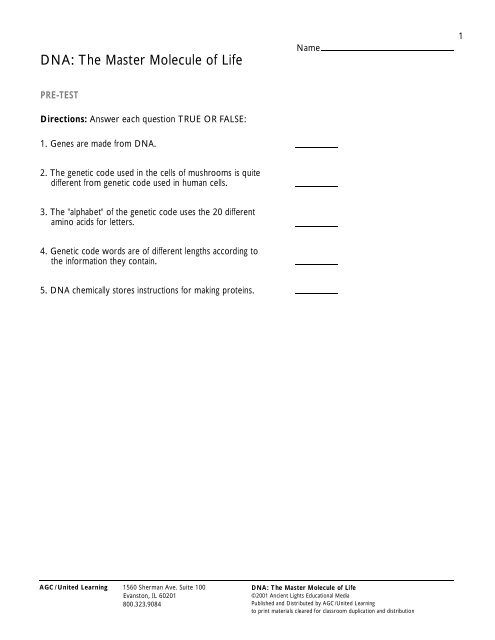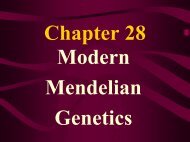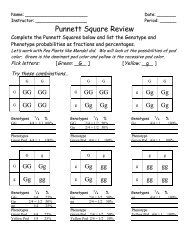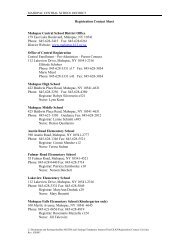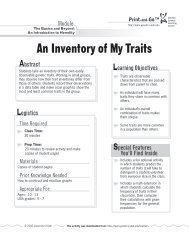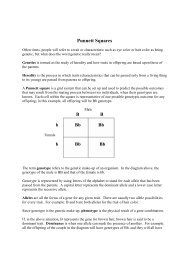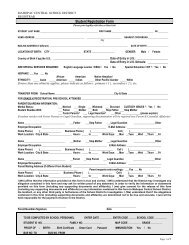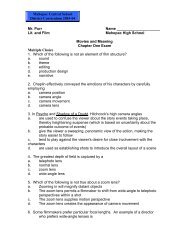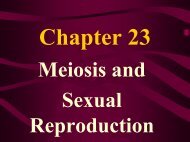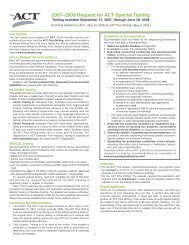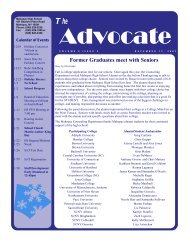D N A: The Master Molecule of Life
D N A: The Master Molecule of Life
D N A: The Master Molecule of Life
You also want an ePaper? Increase the reach of your titles
YUMPU automatically turns print PDFs into web optimized ePapers that Google loves.
D N A: <strong>The</strong> <strong>Master</strong> <strong>Molecule</strong> <strong>of</strong> <strong>Life</strong><br />
N a m e<br />
1<br />
P R E -T E S T<br />
D i r e c t i o n s : Answer each question TRUE OR FA L S E :<br />
1. Genes are made from DNA.<br />
2. <strong>The</strong> genetic code used in the cells <strong>of</strong> mushrooms is quite<br />
different from genetic code used in human cells.<br />
3. <strong>The</strong> "alphabet" <strong>of</strong> the genetic code uses the 20 different<br />
amino acids for letters.<br />
4. Genetic code words are <strong>of</strong> different lengths according to<br />
the information they contain.<br />
5. DNA chemically stores instructions for making proteins.<br />
AGC / United Learning 1560 Sherman Ave. Suite 100<br />
Evanston, IL 60201<br />
800.323.9084<br />
D N A: <strong>The</strong> <strong>Master</strong> <strong>Molecule</strong> <strong>of</strong> <strong>Life</strong><br />
©2001 Ancient Lights Educational Media<br />
Published and Distributed by AGC/United Learning<br />
to print materials cleared for classroom duplication and distribution
D N A: <strong>The</strong> <strong>Master</strong> <strong>Molecule</strong> <strong>of</strong> <strong>Life</strong><br />
N a m e<br />
2<br />
VO C A B U LA RY WORKSHEET<br />
A d e n i n e : A nitrogen containing base found in one <strong>of</strong> the<br />
nucleotide subunits <strong>of</strong> DNA. Adenine is the "A" <strong>of</strong> the<br />
genetic code alphabet.<br />
Amino Acid: <strong>The</strong> subunits that are chemically bonded<br />
together in proteins. <strong>The</strong> order <strong>of</strong> amino acids in a protein<br />
is what gives it the ability to do its job.<br />
A n t i c o d o n : <strong>The</strong> three letter word <strong>of</strong> a transfer RNA that<br />
corresponds to the amino acid it carries. <strong>The</strong> anticodon<br />
matches up with the codon <strong>of</strong> the messenger–RNA.<br />
B a c t e r i a : Simple, one-celled, organisms that lack a nucleus<br />
belonging to the kingdom Monera.<br />
Cell Division: <strong>The</strong> process that results in two cells being<br />
formed from one cell. Cell reproduction.<br />
C h e m i c a l : Chemicals are substances made from combinations<br />
<strong>of</strong> different elements.<br />
Chemical Bonds: <strong>The</strong> way in which atoms are joined to<br />
one another: For example, in water an atom <strong>of</strong> oxygen is<br />
joined to two atoms <strong>of</strong> hydrogen by chemical bonds.<br />
<strong>The</strong> subatomic particles called electrons are responsible<br />
for creating chemical bonds.<br />
Chemical Re a c t i o n s : Events in which chemical bonds are<br />
broken, rearranged and reformed. Matter is changed by<br />
chemical reactions: This is what happens when chemical<br />
compounds react with one another and new compounds<br />
are formed.<br />
C h r o m a t i n : Chromatin is made up <strong>of</strong> the tangled, threadlike,<br />
coils <strong>of</strong> chromosomes. Chromatin contains DNA plus<br />
certain proteins.<br />
C h r o m o s o m e s : Chromosomes are worm-shaped structures<br />
that develop from chromatin before cells divide.<br />
Chromosomes contain DNA and protein. Human body<br />
cells have two full sets <strong>of</strong> 23 different chromosomes.<br />
C o d o n : A code word <strong>of</strong> messenger RNA that represents<br />
an amino acid.<br />
C o m p l e m e n t a r y : Two parts <strong>of</strong> a jigsaw puzzle fit together<br />
to make a whole: <strong>The</strong>refore they are called complementary<br />
parts. DNA has two complementary strands because they<br />
are exact opposites <strong>of</strong> one another.<br />
C y t o p l a s m : All the protoplasm located outside the nucleus.<br />
C y t o s i n e : A nitrogen containing base in a nucleotide<br />
subunit <strong>of</strong> DNA. Cytosine is the "C" <strong>of</strong> the genetic<br />
code alphabet.<br />
Deoxyribonucleic Acid (DNA): A long molecule shaped<br />
like a twisted ladder(double helix). <strong>The</strong> plans for running<br />
and reproducing cells are chemically stored in the DNA.<br />
DNA is found mostly in the nucleus but small amounts <strong>of</strong><br />
DNA are found in mitochondia and chloroplasts.<br />
D e o x y r i b o s e : <strong>The</strong> sugar part <strong>of</strong> a a DNA nucleotide subunit.<br />
Double Helix: <strong>The</strong> double spiral shape <strong>of</strong> the DNA molecule.<br />
E n z y m e s : Proteins that control the rates <strong>of</strong> chemical reactions<br />
in cells. Most proteins in a cell are enzymes. Digestive<br />
enzymes such as pepsin and trypsin are produced by<br />
specialized cells. <strong>The</strong>se enzymes are exported from cells<br />
to break down food in the digestive tract.<br />
G e n e : A region <strong>of</strong> a DNA molecule that stores the instructions<br />
for making a particular protein. Genes are also known<br />
as the units <strong>of</strong> making a particular protein. Genes are also<br />
known as the units <strong>of</strong> heredity.<br />
Genetic Code: <strong>The</strong> chemical language <strong>of</strong> the cell. DNA<br />
stores its instructions in the genetic code.<br />
Genetic Code Wo r d : Three DNA nucleotide subunits in a<br />
r o w, such as AAA or AGA, that represent amino acids.<br />
Genetic Tr a n s c r i p t i o n : <strong>The</strong> process <strong>of</strong> copying a gene into<br />
m e s s e n g e r- R N A .<br />
G u a n i n e : A nitrogen–containing base found in a nucleotide<br />
subunit <strong>of</strong> DNA that is the "G" <strong>of</strong> the genetic code alphabet.<br />
H e r e d i t y : Characteristics that are passed on from<br />
parents to their <strong>of</strong>fspring. Genes are called the "units<br />
<strong>of</strong> heredity” .<br />
H e r e d i t a r y : Passed on from one generation to the next.<br />
Hydrogen Bond: A type <strong>of</strong> weak chemical bond. Hydrogen<br />
bonds exist between the two strands <strong>of</strong> the DNA molecule<br />
and between the messenger RNA codons and the transfer<br />
RNA anticodons.<br />
M o l e c u l e : A combination <strong>of</strong> two or more atoms bonded<br />
together by strong chemical bonds (covalent bonds).<br />
continued<br />
AGC/ United Learning 1560 Sherman Ave. Suite 100<br />
Evanston, IL 60201<br />
800.323.9084<br />
D N A: <strong>The</strong> <strong>Master</strong> <strong>Molecule</strong> <strong>of</strong> <strong>Life</strong><br />
©2001 Ancient Lights Educational Media<br />
Published and Distributed by AGC/United Learning<br />
to print materials cleared for classroom duplication and distribution
D N A: <strong>The</strong> <strong>Master</strong> <strong>Molecule</strong> <strong>of</strong> <strong>Life</strong><br />
N a m e<br />
2a<br />
M a c r o m o l e c u l e : A very large molecule made from thousands<br />
<strong>of</strong> atoms. DNA, messenger RNA and proteins are<br />
all examples <strong>of</strong> macromolecules.<br />
Messenger RNA (m-RNA): Messenger RNA carries instructions<br />
for making proteins from the nucleus to a ribosome.<br />
Nitrogenous Bases: <strong>The</strong> nitrogen containing bases <strong>of</strong> the<br />
DNA nucleotide subunits whose chemical names are<br />
Adenine, Thymine, Cytosine, and Guanine.<br />
N u c l e a r : Refers to the nucleus.<br />
Nucleic Acids: DNA or RNA nucleus (Plural: Nuclei)<br />
A rounded structure located in the cytoplasm. <strong>The</strong> nucleus<br />
is the cell's control center because it is where most <strong>of</strong> the<br />
DNA is located.<br />
N u c l e o l u s ( N e w- k l e e -oh-lus): "Little Nucleus" <strong>The</strong> area <strong>of</strong><br />
the nucleus where ribosomes are made. Cells can have<br />
more than one nucleolus.<br />
Nucleotide Subunit: <strong>The</strong> Subunits that make up DNA.<br />
Each nucleotide has a phosphate group, a deoxyribose<br />
sugar group and a nitrogen–containing base; either<br />
Adenine, Thymine, Cytosine or Guanine.<br />
O r g a n e l l e s : "Little Organs". Structures in the cytoplasm<br />
such as mitochondria, ribosomes, chloroplasts, and Golgi<br />
bodies where different tasks are performed in the cell.<br />
Pr o t e i n s : <strong>Molecule</strong>s made up <strong>of</strong> long chains <strong>of</strong> amino<br />
acids(polypeptides). Proteins build living material, fight disease,<br />
and help transport things out <strong>of</strong> the cell. <strong>The</strong> important<br />
class <strong>of</strong> proteins called e n z y m e s act to control the<br />
rates <strong>of</strong> chemical reactions. Most proteins are enzymes.<br />
Replication <strong>of</strong> DNA: <strong>The</strong> process that occurs when DNA<br />
makes an exact copy <strong>of</strong> itself before cell division.<br />
R i b o s o m e s : <strong>The</strong> organelles where proteins are assembled.<br />
Ribonucleic Acid: A type <strong>of</strong> nucleic acid that contains the<br />
sugar ribose instead <strong>of</strong> deoxyribose, has one strand and<br />
that has the base Uracil instead <strong>of</strong> Thymine.<br />
R i b o s e : A sugar group found in RNA nucleotide subunits.<br />
Structural Formula: A diagram used by chemists that<br />
shows how atoms are arranged in molecules.<br />
S y n t h e s i s : To make complex substances from simpler parts.<br />
Proteins are synthesized from amino acid subunits. DNA is<br />
synthesized from nucleotide subunits.<br />
S u g a r-Phosphate Bonds: Strong (covalent) bonds between<br />
the deoxyribose sugar <strong>of</strong> one nucleotide and the phosphate<br />
group <strong>of</strong> the adjoining nucleotide is what forms the "backbone"<br />
<strong>of</strong> the DNA molecule.<br />
Terminator Codons: Every messenger RNA message ends<br />
with one <strong>of</strong> three different "terminator" codons: UAG, UA A<br />
or UGA. Since there are no transfer RNAs with anticodons<br />
to match these messenger RNA codons protein synthesis<br />
stops whenever a terminator codon is reached.<br />
T h y m i n e : A nitrogen containing base found in one <strong>of</strong> the<br />
nucleotide subunits <strong>of</strong> DNA. Thymine is the "T" <strong>of</strong> the<br />
genetic code alphabet.<br />
Transfer RNA (t-RNA): A small RNA molecule that can pick<br />
up amino acids. By matching the transfer RNA anticodon to<br />
the messenger RNA codon the amino acid is put into the<br />
protein chain correctly.<br />
Tr a n s l a t i o n : <strong>The</strong> process <strong>of</strong> making proteins using the<br />
instructions <strong>of</strong> messenger RNA molecule.<br />
U r a c i l : A nitrogen–containing base used in RNA molecules<br />
instead <strong>of</strong> Thymine.<br />
VO C A B U LA RY AC T I V I T Y<br />
From the vocabulary list find the correct word to fill<br />
in the blanks.<br />
1. are proteins that control the<br />
rates <strong>of</strong> chemical reactions.<br />
2. Two or more atoms strongly bonded together<br />
is called a<br />
3. Instructions from DNA are carried to ribosomes by<br />
molecules <strong>of</strong><br />
4. Amino acids are picked up by special RNA<br />
molecules called<br />
5. <strong>The</strong> process <strong>of</strong> making something from simple<br />
subunits is called<br />
AGC / United Learning 1560 Sherman Ave. Suite 100<br />
Evanston, IL 60201<br />
800.323.9084<br />
D N A: <strong>The</strong> <strong>Master</strong> <strong>Molecule</strong> <strong>of</strong> <strong>Life</strong><br />
©2001 Ancient Lights Educational Media<br />
Published and Distributed by AGC/United Learning<br />
to print materials cleared for classroom duplication and distribution
D N A: <strong>The</strong> <strong>Master</strong> <strong>Molecule</strong> <strong>of</strong> <strong>Life</strong><br />
N a m e<br />
3<br />
CROSSWORD PUZZLE<br />
A c r o s s :<br />
1. A messenger-RNA code word<br />
is called a .<br />
3<br />
4<br />
2. is the process that<br />
takes place when proteins are made<br />
from the instructions <strong>of</strong> messenger- R N A .<br />
3. Tr a n s f e r-RNA carries<br />
to the messenger- R N A .<br />
4. is the process that<br />
takes place when DNA makes a copy<br />
<strong>of</strong> itself.<br />
2<br />
2<br />
1<br />
5. All genetic code words have<br />
" l e t t e r s " .<br />
6. Fo u r subunits are<br />
needed to make a DNA molecule.<br />
3<br />
1<br />
D o w n :<br />
1. <strong>The</strong> DNA molecule is called a<br />
because it is<br />
very large.<br />
is the process by which<br />
DNA is copied into messenger RNA.<br />
3. Most <strong>of</strong> a cell's DNA is found in its<br />
4. Proteins are made on organelles called<br />
5. A region <strong>of</strong> the DNA molecule that<br />
stores instructions for a protein is called a<br />
.<br />
.<br />
.<br />
4<br />
5<br />
6<br />
5<br />
AGC/ United Learning 1560 Sherman Ave. Suite 100<br />
Evanston, IL 60201<br />
800.323.9084<br />
D N A: <strong>The</strong> <strong>Master</strong> <strong>Molecule</strong> <strong>of</strong> <strong>Life</strong><br />
©2001 Ancient Lights Educational Media<br />
Published and Distributed by AGC/United Learning<br />
to print materials cleared for classroom duplication and distribution
D N A: <strong>The</strong> <strong>Master</strong> <strong>Molecule</strong> <strong>of</strong> <strong>Life</strong><br />
N a m e<br />
4<br />
P R E -T E S T<br />
D i r e c t i o n s : Define each <strong>of</strong> the following.<br />
1. Messenger RNA–<br />
2. Genetic code word–<br />
3. Anticodon–<br />
4. Transfer RNA–<br />
5. Pr o t e i n s –<br />
6. Ribosome–<br />
7. Amino acid–<br />
8. Nucleotide Subunit–<br />
9. Macromolecule–<br />
10. Replication <strong>of</strong> DNA–<br />
AGC / United Learning 1560 Sherman Ave. Suite 100<br />
Evanston, IL 60201<br />
800.323.9084<br />
D N A: <strong>The</strong> <strong>Master</strong> <strong>Molecule</strong> <strong>of</strong> <strong>Life</strong><br />
©2001 Ancient Lights Educational Media<br />
Published and Distributed by AGC/United Learning<br />
to print materials cleared for classroom duplication and distribution
D N A: <strong>The</strong> <strong>Master</strong> <strong>Molecule</strong> <strong>of</strong> <strong>Life</strong><br />
N a m e<br />
5<br />
VIDEO QUIZ<br />
Directions: Define each <strong>of</strong> the following.<br />
1. True or False <strong>The</strong> four subunits <strong>of</strong> DNA are used as<br />
the "letters" <strong>of</strong> the genetic code alphabet.<br />
2. True or False Genetic code words represent<br />
different proteins.<br />
3. True or False Translation takes place on ribosomes.<br />
4. True or False <strong>The</strong>re is usually one gene on each<br />
chromosome.<br />
5. True or False DNA is transcribed into messenger<br />
RNA in the nucleus.<br />
AGC/ United Learning 1560 Sherman Ave. Suite 100<br />
Evanston, IL 60201<br />
800.323.9084<br />
D N A: <strong>The</strong> <strong>Master</strong> <strong>Molecule</strong> <strong>of</strong> <strong>Life</strong><br />
©2001 Ancient Lights Educational Media<br />
Published and Distributed by AGC/United Learning<br />
to print materials cleared for classroom duplication and distribution


